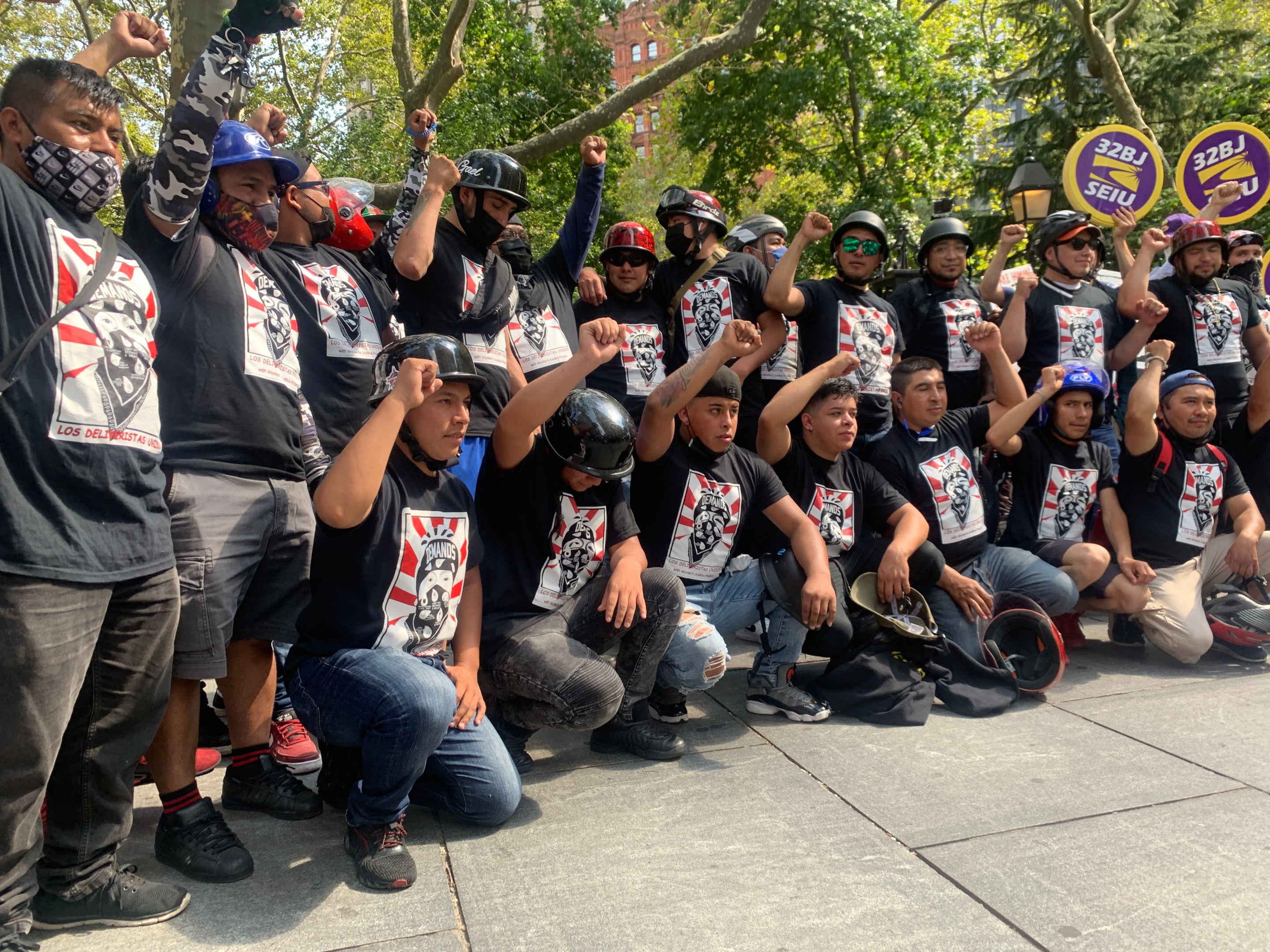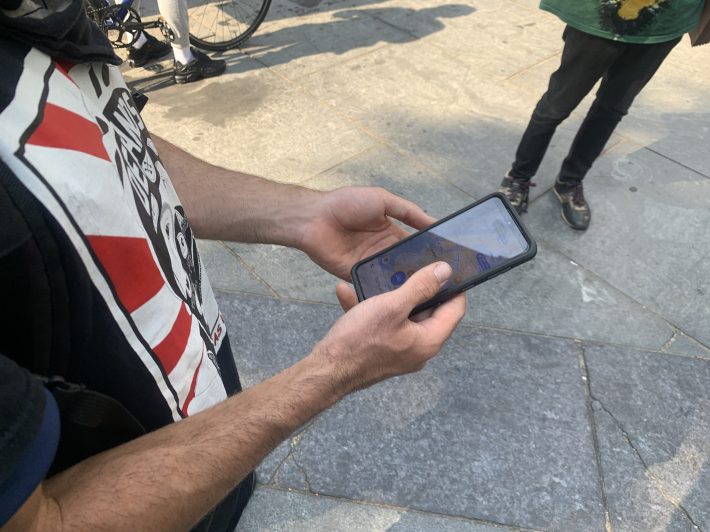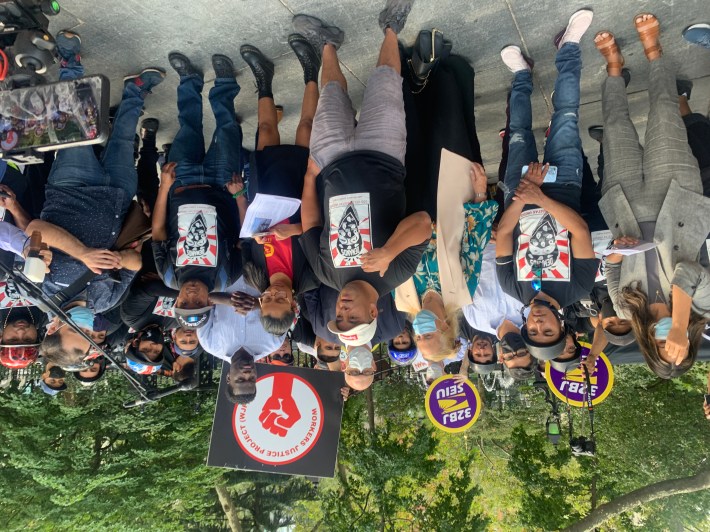Report: New York’s Essential Delivery Workers are Underpaid, Underappreciated, Victimized
11:09 PM EDT on September 13, 2021

Delivery workers rallied at City Hall on Monday to protest working conditions and danger. Photo: Gersh Kuntzman
Low pay. Grueling hours. Long work weeks. Theft. Crashes. Discomfort. Disrespect.
This is the life of the New York City delivery worker, according to a landmark survey of 500 deliveristas issued Monday by the Workers’ Justice Project and the Worker Institute at School of Industrial and Labor Relations at Cornell University [full report embedded below].
The top-line findings sound like they are plucked from the pages of a Dickens novel:
- A strong majority of workers (64 percent) work six days a week — and 33 percent work every single day. App delivery companies claim their services provide part-timers with flexibility to set their own schedule, but, in fact, only 8 percent of survey respondents said they work one or two days a week only.
- Forty-nine percent of survey respondents reported having been in a crash during a delivery. Of those, 75 percent said they paid for their own medical care.
- Delivery workers say their average pay (after expenses) is $7.87 per hour, excluding tips, which deliveristas say comprise 44 percent their earnings. Tips are, of course, not reliable.
- A majority — 53 percent — said they had access to restaurant bathrooms only sometimes, and 30 percent said they never had bathroom access.
- Another majority — 54 percent — said their bikes had been stolen. About 30 percent of those victims said the robbery was physically violent.
"This study validates what we have been saying all this time [and] puts pressure on the city to finally do something for us," said delivery worker Gustavo Ajche. "This study only gives us more strength to keep fighting against these giant companies that are not treating us as the essential workers we are."
Here's a deeper dive into the survey, "Essential But Unprotected: App-Based Food Couriers in New York City," which was conducted between December 2020 and April 2021.
Who are they

There are roughly 65,000 delivery workers in the city, according to the Workers Justice Project. The survey offered a glimpse at who they are and how they work:
- Half of delivery workers get around on bikes or motor-scooters. Only 17 percent uses cars.
- A huge majority of workers — 77 percent — said that "most" of their orders come from fast-food establishment, which likely means a smaller tip.
- All but 5 percent identify as male. About 76 percent are between 20 and 39 years old.
- About 30 percent are Latinx and 20 percent are Asian.
- Virtually all delivery workers surveyed have been doing this work for less than two years, an indication of the rising need for delivery workers and how short a delivery worker's career is. Only 1 percent of workers said they had been delivering for more than five years. About half have been working since the pandemic. "The pandemic was the most cited reason for working [as] this was the only job they could find," the report says.
The main complaints
There are multiple app-based delivery companies, all of which treat workers as "independent contractors." The workers say that as a result of that "gray area" status, they lack normal labor protections such as the guaranteed New York City minimum wage, unemployment insurance, sick leave, the right to form a union, workers’ compensation after injuries, and workplace health and safety regulations.
"App companies have anchored their business model on the independent contractor premise, thereby shifting the costs of operations and safety net protections to the workers, consumers and, ultimately, to the broader society," said Patricia Campos-Medina, the executive director of the Worker Institute at ILR-Cornell University. "Failure to regulate these applications is leaving workers across the platform economy without basic protections."
Delivery workers also complain of a dizzying array of rules, practices and approaches implemented by the apps that affect worker pay and their ability to get work.
"The apps’ performance evaluation systems rely largely on workers’ acceptance of orders and consumer ratings," the report said. For instance, a worker's internal rating might be lowered by the app company if he rejects making a specific, unprofitable delivery. A reduced ranking could result in fewer or less-favorable time slots," the report claims.
To get good ratings from customers, delivery workers must travel long distances at breakneck speeds. "The concentration of delivery work in [a few] neighborhoods [causes] an influx of motorized e-bikes and safety concerns both for delivery workers and the public," the report said. "This can stress the existing bicycle infrastructure (lanes, bike parking, etc.) in these neighborhoods."
The competition among the various apps makes it even harder for workers to make a living, the report adds.

"Company policies impede working for multiple apps at the same time," according to the report. "For example, UberEats uses a quest system that incentivizes staying on their app the whole day or week. DoorDash and GrubHub use a shift system, in which workers who try to use multiple apps and pause their shift risk being kicked off the shift. For the apps’ algorithms, getting expelled from a shift counts as a missed shift, which negatively impacts the worker’s ability to sign up for future shifts and can result in their deactivation from the app."
"In this report, we deliveristas spoke up without fear about the reality that we are experiencing in the streets with these apps," delivery worker Antonio Solis, who lives in Astoria, said at Monday's rally at City Hall. "This study tells the truth about and debunks what the apps have been saying, like DoorDash saying it pays us $33 per hour. Who gets $33 an hour?"
None of the 50 or so deliveristas surrounding Solis responded.
"They force us to travel long distances, faster, that puts us in danger [of crashes and robberies]," he added. "The robberies and assaults are more violent — with knives and guns. Now more than ever, we are organized and united so that our work is treated with dignity and the city sees us as essential, not just with words, but with actions. ... We deserve it because we are risking our lives without knowing we will come back home to our families."
So what is being done?
The City Council has a package of bills that would tinker around the edges of this massive, multi-million-dollar industry:
- Int. 2288 (Council Member Justin Brannan) would require app companies to provide proper food delivery bags to workers for free, which might lead to more consistent tips because food might arrive warmer.
- Int. 2289 (Brannan) would give workers "the option to set a maximum distance for trips" and would bar the apps "from imposing any negative consequences on delivery workers as a result of the limitations they have chosen."
- Int. 2294 (Brad Lander) would require minimum per trip payments.
- Int. 2296 (Carlos Menchaca) would bar apps "from charging workers any fees to receive payment" and would set up payment systems for the unbanked.
- Int. 2298 (Carlina Rivera) would require restaurants to allow workers to use the bathroom.
Rivera, Brannan and Lander were on hand with workers, who read the names of the nine delivery workers who have died this year, including Noe Amador Licona; Jose Garcia Gomez; Tarek Aziz; Federico Zaput Palax; Borkot Ullah; Xing Long Lin; Luis Alvaro Hernandez; Francisco Villalva Vitino; and Juan Lucirgo Cruz.
"I will stop at nothing to get these bills passed," Rivera said, though she added that the bills "won't solve everything" such as the constant fear of robberies and road violence.
Industry response
DoorDash has been trying to improve what the report suggests is a deservedly bad reputation. It is sponsoring, for example, the Transportation Alternatives "Vision Zero Cities" conference this year, and late last year, sponsored several pro-delivery worker initiatives.
The company sent over the following statement:
Nationally, Dashers earn over $25 per hour they’re on a delivery and Dashers earn $33 per hour they’re on a delivery in Manhattan. ... On average, Dashers deliver for fewer than four hours per week, fitting delivery around full time jobs, caring for friends and family, going to school, and more. ... We are actively engaged with the Dasher community and eager to engage with policymakers on ways all stakeholders can better support New York City delivery workers.
The company also questioned the methodology of the survey, which relied on "snowball sampling" (i.e. one deliverista tells another worker about the survey and so on...). (The report's authors disputed that the methodology undermines the survey: "Even though this is a non- random sample, it is very close to being representative of the relevant population, as the organizers recruited participants in dozens of public sites where delivery workers congregate across New York City.")
DoorDash also claimed that its workers — even though they are "independent contractors" — do automatically qualify for occupational accident insurance coverage, which is described on this DoorDash web page. But when Streetsblog asked how many workers ever got a settlement from said insurance, the company could not provide any numbers.
Streetsblog also asked about the claim of workers being paid $33 an hour while "on a delivery" because it is unclear what that means. According to the company, "on a delivery" means the time between accepting an order and dropping it off at a customer. But workers complained repeatedly of having downtime between deliveries for which they are obviously not being paid.
"We found 71 percent of delivery workers typically wait 15 minutes or more to get their next order," the report said. "In the absence of a guaranteed minimum pay per hour, delivery workers struggle to make a living, often waiting hours a day for work."
A spokesman for UberEATS did not respond to an email.
Los Deliveristas Unidos - Industry Report by Gersh Kuntzman on Scribd
Gersh Kuntzman is editor in chief of Streetsblog NYC and Streetsblog USA. He also writes the Cycle of Rage column, which is archived here.
Read More:
Stay in touch
Sign up for our free newsletter
More from Streetsblog New York City
Stockholm Leader’s Message to NYC: ‘Congestion Pricing Just Works’
"In Stockholm, people really thought that congestion pricing would be the end of the world, the city will come to a standstill, no one would be able to get to work anymore and all the theaters and shops would just go bankrupt. None of that happened."
Friday’s Headlines: Trump Trial Trumps Safety Edition
Is anyone going to bother to fix the dangerous mess on the streets and plazas around the Trump trial? Plus more news.
Adams Offers Bare Minimum to Seize Congestion Pricing’s ‘Space Dividend’ Opportunity
The mayor's list of projects supposedly meant to harness congestion pricing's expected reduction in traffic is mostly old news, according to critics.
OPINION: Congestion Pricing Will Help My Family Get Around As We Navigate Cancer Treatment
My partner was recently diagnosed with cancer. Congestion pricing will make getting her to treatment faster and easier.




